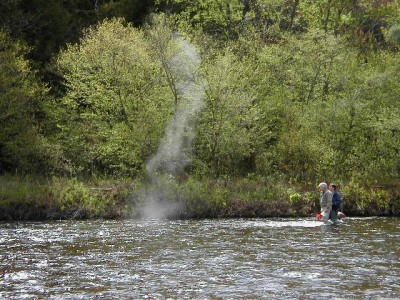“Just scatter my ashes and have a big party” We hear it a lot these days. Such celebrations of life are easy and parties are fun, right? It should be easy, but without some thoughtful planning, survivors are faced with many unanswered questions.
Often the scattering may be put off because of all the unanswered questions (“Do I need a scattering urn?”, “What’s the best way to scatter ashes?”, etc.)and the ashes can end up on that top shelf in the hallway closet indefinitely. Helping people learn how to have a creative and meaningful scattering ceremony is a large part of the reason that Cremation Solutions exists.

Families are grateful to learn that they can create a meaningful event and still follow the persons request to “just scatter me”. Scattering ashes is often the final act of love that survivors can participate in. Scattering is nothing less than a committal service, it is an event that should contain ceremony and ritual. It is important for family and friends to experience a meaningful and memorable final tribute.
People who choose to have their ashes scattered do not consider scattering to be any less respectful or meaningful than any other disposition option. In fact, families that have scattered are experiencing a higher level of satisfaction. They consider scattering to be a more natural way to return loved ones to the earth. Scattering also allows families the flexibility of choosing a site that is personable and has special meaning to the deceased and the survivors. Sites with natural beauty or familial significance are also often selected.
Ash scattering is becoming fairly common in North America with more than half of all cremated Americans and Canadians choosing the scattering of ashes. In fact scattering is now the most common disposition of cremated remains in the United States and Canada. And the number of people selecting cremation continues to grow, not only in North America, but also internationally in such areas as Europe, the United Kingdom, and Australia.
However, funeral professionals are the only ones that aren’t catching on. Most funeral professionals consider scattering a dirty and unprofitable choice of final disposition. They will eagerly help with a burial, an interment, or the planning and creation of funeral and memorial events, but when the choice is to scatter, they will help you as far as the door!
Some of the more progressive funeral homes now offer special urns for families that choose to scatter the ashes, but that’s about as far as it goes. Cremation Solutions was started when our founder, a funeral director for over twenty years noticed how those who choose to scatter have been so neglected by the funeral professionals in general. He created Cremation Solutions to be an informative and authoritative source of information for those choosing to scatter.
Here are some things to consider when planning a scattering ceremony. Hopefully a funeral or memorial event will take place before the scattering ceremony. Planning these events are what funeral professionals are really good at. Even if you’re not having public viewing and or visitation, you should still give survivors the chance to gather and celebrate the life that was lived. This helps survivors not only with the healing process but also to continue important relationships with each other and to support those who really need it.
For the scattering ceremony you should consider first if you want a public ceremony or will it just be the family gathering. For a public ceremony, you might want the scattering to follow the memorial event, just like when a procession follows to the cemetery for committal services.
- Will more than one person scatter the ashes or will there be a chance to share in the scattering of ashes?
- Will the gathering be at the place of the scattering or somewhere else, either before or after?
- Will there be more than one scattering if there are relatives or friends in another part of the country? If people know the date and time the scattering will occur, they can then take that time to honor the memory of the deceased in their own way.
As the popularity of scattering ashes has grown, new options for remembrance have been created. Three popular product types that relate specifically to families that desire to scatter are scattering urns, keepsakes, and keepsake jewelry.

Scattering urns can be displayed at services, creating a focal point and sense of reality. Urns allow the cremated remains to be easily disbursed while adding dignity to the process. The location of the scattering sometimes determines the style of scattering urn to be used. The most popular location is over water and there are many water soluble urns that are specifically designed for this purpose.
The second most popular location is on the family property. Birdhouse memorial urns are a great option for these families because they are scattering urns that will convert into a memorial birdhouse, providing comfort for the years to come. Some scattering urns can be kept as an art piece or provide a place to keep mementos of the deceased or be used as a vase.
Because scattering is irreversible, keeping some of the ashes can be very important to the family that chooses to scatter. If families relocate, they can be left with feelings of abandonment. Keepsake urns and jewelry help provide the comforting knowledge that part of the earthly remains can always be kept close. They come in many sizes and styles and can usually be ordered match the style of the scattering urn. Keepsakes can be used to contain the ashes as well as jewelry, hair or other mementos of the deceased.
Scattering is not new a new practice: it has been happening for over a thousand years, but it has lost much of its ritual, most of which never made its way into modern times. Research tells us that today’s families still want meaningful celebrations of life with ceremony and personal memorable tributes.
Many families are hiring or consulting with funeral celebrants to help create and a more meaningful and memorable event. Funeral celebrants are ceremony specialists who have a sound background in the history of ritual, ceremony and funeral traditions in many cultures and religions. Funeral Celebrants have been drawn to this work by a strong realization that every life has meaning and deserves to be celebrated and celebrated well. Many have experienced grief themselves. All are convinced that funerals can be a valuable source of healing. Nothing can take away the grief, but a genuine, well prepared tribute may ease the pain. Whether your family is secular, religious, spiritual or interfaith, or if you simply wish to express yourself in a manner of your own, choosing a Celebrant can help to create a meaningful, memorable, fitting end of life tribute.
If you have any question about scattering ashes, cremation urns, scattering urns, or anything else, please feel free to contact Cremation Solutions for further info.

It’s interesting to learn that when it comes to scattering ashes that there are somethings that we need to consider before making final decisions. One that you mentioned that I never consider is if the gathering place is where we want to scatter or somewhere else. This is something that we will have to remember when it comes to planning the ceremony to scatter my father’s ashes at his favorite camping site.
The Catholic Church Funeral Rites regarding Cremation of the Body.
Due to the changing trends in funeral practices, the U.S. Bishops’ “Order of Christian Funerals” and “Reflections on the Body, Cremation, and Catholic Funeral Rites” documents, which were consulted as source material, are as follows:
Cremation (using fire and heat) is the process by which the body of the deceased is reduced to its basic elements. Cremation is permitted for Catholics as long as it is not chosen in denial of Christian teaching on the Resurrection and the sacredness of the human body. Although cremation is permitted, Catholic teaching continues to stress the preference for burial or entombment of the body of the deceased. This is done in imitation of the burial of Jesus’ body. “This is the Body once washed in baptism, anointed with the oil of salvation, and fed with the bread of life. Our identity and self –consciousness as a human person are expressed in and through the body…Thus, the Church’s reverence and care for the body grows out of a reverence and concern for the person whom the Church now commends to the care of God.” 1
When cremation is chosen for a good reason, the full course of the “Order of Christian Funerals” should still be celebrated, including the Vigil Service/Rosary (wake), the Funeral Liturgy, and the Rite of Committal. The preservation of this order allows for the greater expression of our beliefs and values, especially, the sacredness of human life, the dignity of the individual person and the Resurrection of Jesus Christ, the firstborn of the dead. Through its funeral rites, the Church commends the dead to the merciful love of God and pleads for the forgiveness of their sins.
Church teaching insists that cremated remains must be given the same respect as the body, including the manner in which they are carried and the attention given to their appropriate transport and placement. The cremated remains of a body are to be buried or entombed, preferably in a Catholic cemetery, and using the rites provided by the” Order of Christian Funerals”.
The following are not considered to be reverent dispositions that the Church requires and therefore not allowed:
* scattering cremated remains
* dividing cremated remains
* and keeping cremated remains in the home
The remains of a cremated body should be treated with the same respect given to the corporeal remains of a human body. This includes a worthy container to hold the cremated remains.
1. Reflections on the Body, Cremation, and Catholic Funeral Rites, Committee on the Liturgy, USCCB, 1997